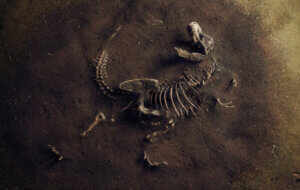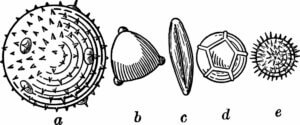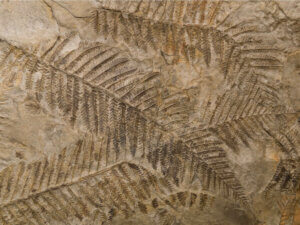What Is Paleoecology?


Written and verified by the biologist Miguel Mata Gallego
Paleoecology is the science dedicated to discovering the ecology of the past. Therefore, its task is to describe environments and trophic relationships of animals and plants that lived on Earth hundreds, thousands, and even millions of years ago.
How can we find out what the vegetation was like in a particular place thousands of years ago? What tools does this discipline use to unravel the mysteries of the past? We’ll tell you about all this and much more in this article.
The secrets hidden in lakes
To start exploring the world of paleoecology, we suggest the reader lets his or her imagination run wild and mentally see himself/herself on the shores of a small lake.
We can imagine a beautiful lake with turquoise waters surrounded by a few young pines. Or, if we prefer, we can think of a dark deep Scottish lake surrounded by hundred-year-old oaks with branches swaying in the wind.
Whichever body of water comes to mind, they all have one thing in common. Even if it doesn’t seem so, on the bottom of them, they store valuable information for ecologists.
Over the years, the pollen excreted by vegetation surrounding the bodies of stagnant water— lakes, reservoirs and small ponds— ends up falling into the water and, then, to the bottom of lakes. This pollen ends up accumulating in sediments. Year after year, it forms an increasingly thick layer on the bottom of lakes.
Palynology, a look at the vegetation of the past
Thanks to sophisticated drilling techniques, ecologists extract cores from sediments. This process is similar to extracting ice cores from glaciers or the poles. Once extracted, these cores contain fossilized pollen from vegetation that, in the distant past, surrounded the lake.
Therefore, palynology, or analysis of fossilized pollen, is tremendously useful to researchers. This allows them to know the evolution of the vegetation in a specific place. Thus, scientists are able to glimpse, as if from a window, the past of plants from those ecosystems.

Paleontology: the study of animal fossils
As we can imagine, palynology is one of the most useful, modern, and cheapest tools we have to discover the state of ecosystems from the past.
By knowing the plants that existed, we can deduce which herbivorous animals ate them, and so on until we cover the entire food chain. However, paleoecology made its first steps with the study of animal fossils.
The study of fossils —or paleontology— allows us to know what organisms were like millions of years ago. Thanks to the fossilization process, some animals’ remains were preserved in time as rocks in the layers that form the Earth’s crust.
The study of fossils allows us to discover animals’ evolution up to the present. This is the case of fossils, which show us our past as human beings. Australopithecus, the archaeological site of Atapuerca and the Neanderthal man are examples of fossils that shed light on our past.
Fossils of extinct animals and paleoecology
Probably the most amazing thing about the animal fossil record is the discovery of entire species or taxonomic groups of animals that no longer live among us.
For instance, the best-known case is that of the dinosaurs. These “terrible lizards” dominated the Earth between 65 and 250 million years ago. Their disappearance, scientists believe, was due to the impact of a meteorite on the Earth, leaving birds as their only currently surviving group.
Paleontologists have been able to analyze dinosaurs’ fossils in great detail. They’ve reached very interesting conclusions about their way of life.
In addition, one of the most curious studies that exists in this respect is the analysis of fossilized skulls. It provides a lot of information about the brain capacity of dinosaurs. For example, we know today that the Velociraptor was an extremely intelligent animal.
Dinosaur fossils are the best-known example to the general public. Nevertheless, there are numerous groups of animals that became extinct, and we only know about them thanks to fossilized remains.
Burgess Shale, a unique place for paleoecology
Burgess Shale is probably the best place in the world to study the paleoecology of Cambrian organisms. On this site, located in the heart of the Canadian Rockies, we can find thousands of fossils of organisms of a splendid variety.
What makes this place unique is its formation due to a clay avalanche that trapped thousands of marine animals from the Cambrian period —trilobites, mollusks, arthropods and other ancestral invertebrates— while they were still alive. Therefore, the reconstruction of their ecology becomes easier.
Thus, paleoecologists can study thousands of fossils that otherwise wouldn’t have been found. The example of Hallucigenia, an Onychophora that got its name because of its incredible body covered with thorns, is notorious.

In conclusion, we can see how paleoecology, either through the study of fossilized pollen or animal fossils preserved in the rock, allows us to reconstruct with incredible precision environments and ecosystems of the past.
Paleoecology is the science dedicated to discovering the ecology of the past. Therefore, its task is to describe environments and trophic relationships of animals and plants that lived on Earth hundreds, thousands, and even millions of years ago.
How can we find out what the vegetation was like in a particular place thousands of years ago? What tools does this discipline use to unravel the mysteries of the past? We’ll tell you about all this and much more in this article.
The secrets hidden in lakes
To start exploring the world of paleoecology, we suggest the reader lets his or her imagination run wild and mentally see himself/herself on the shores of a small lake.
We can imagine a beautiful lake with turquoise waters surrounded by a few young pines. Or, if we prefer, we can think of a dark deep Scottish lake surrounded by hundred-year-old oaks with branches swaying in the wind.
Whichever body of water comes to mind, they all have one thing in common. Even if it doesn’t seem so, on the bottom of them, they store valuable information for ecologists.
Over the years, the pollen excreted by vegetation surrounding the bodies of stagnant water— lakes, reservoirs and small ponds— ends up falling into the water and, then, to the bottom of lakes. This pollen ends up accumulating in sediments. Year after year, it forms an increasingly thick layer on the bottom of lakes.
Palynology, a look at the vegetation of the past
Thanks to sophisticated drilling techniques, ecologists extract cores from sediments. This process is similar to extracting ice cores from glaciers or the poles. Once extracted, these cores contain fossilized pollen from vegetation that, in the distant past, surrounded the lake.
Therefore, palynology, or analysis of fossilized pollen, is tremendously useful to researchers. This allows them to know the evolution of the vegetation in a specific place. Thus, scientists are able to glimpse, as if from a window, the past of plants from those ecosystems.

Paleontology: the study of animal fossils
As we can imagine, palynology is one of the most useful, modern, and cheapest tools we have to discover the state of ecosystems from the past.
By knowing the plants that existed, we can deduce which herbivorous animals ate them, and so on until we cover the entire food chain. However, paleoecology made its first steps with the study of animal fossils.
The study of fossils —or paleontology— allows us to know what organisms were like millions of years ago. Thanks to the fossilization process, some animals’ remains were preserved in time as rocks in the layers that form the Earth’s crust.
The study of fossils allows us to discover animals’ evolution up to the present. This is the case of fossils, which show us our past as human beings. Australopithecus, the archaeological site of Atapuerca and the Neanderthal man are examples of fossils that shed light on our past.
Fossils of extinct animals and paleoecology
Probably the most amazing thing about the animal fossil record is the discovery of entire species or taxonomic groups of animals that no longer live among us.
For instance, the best-known case is that of the dinosaurs. These “terrible lizards” dominated the Earth between 65 and 250 million years ago. Their disappearance, scientists believe, was due to the impact of a meteorite on the Earth, leaving birds as their only currently surviving group.
Paleontologists have been able to analyze dinosaurs’ fossils in great detail. They’ve reached very interesting conclusions about their way of life.
In addition, one of the most curious studies that exists in this respect is the analysis of fossilized skulls. It provides a lot of information about the brain capacity of dinosaurs. For example, we know today that the Velociraptor was an extremely intelligent animal.
Dinosaur fossils are the best-known example to the general public. Nevertheless, there are numerous groups of animals that became extinct, and we only know about them thanks to fossilized remains.
Burgess Shale, a unique place for paleoecology
Burgess Shale is probably the best place in the world to study the paleoecology of Cambrian organisms. On this site, located in the heart of the Canadian Rockies, we can find thousands of fossils of organisms of a splendid variety.
What makes this place unique is its formation due to a clay avalanche that trapped thousands of marine animals from the Cambrian period —trilobites, mollusks, arthropods and other ancestral invertebrates— while they were still alive. Therefore, the reconstruction of their ecology becomes easier.
Thus, paleoecologists can study thousands of fossils that otherwise wouldn’t have been found. The example of Hallucigenia, an Onychophora that got its name because of its incredible body covered with thorns, is notorious.

In conclusion, we can see how paleoecology, either through the study of fossilized pollen or animal fossils preserved in the rock, allows us to reconstruct with incredible precision environments and ecosystems of the past.
All cited sources were thoroughly reviewed by our team to ensure their quality, reliability, currency, and validity. The bibliography of this article was considered reliable and of academic or scientific accuracy.
Hilton, A. (2014). Phylogeny of Hallucigenia.
Morris, S. C., & Whittington, H. B. (1979). The animals of the Burgess Shale. Scientific American, 241(1), 122-135.
Zapata, M. R., García, M. G., Valiño, M. D., Rodríguez, A. V., Vegas, J., & Pérez-González, A. (2002). Clima y vegetación durante el Tardiglaciar y el Holoceno en la Sierra de Neila (Sistema Ibérico Noroccidental). Cuaternario y Geomorfología, 16(1-4), 9-20.
This text is provided for informational purposes only and does not replace consultation with a professional. If in doubt, consult your specialist.








